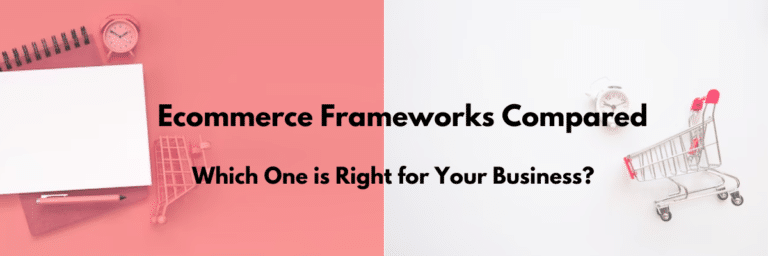7 Tips for Creating Top-Notch Ecommerce Marketing Strategies
Ecommerce marketing strategies are the techniques and tactics used by online businesses to promote and sell their products or services.
For e-commerce businesses to succeed and stand out, they need to adopt effective marketing strategies. This can help them reach and engage their target audiences, build brand recognition, and convert website visitors into loyal customers.
In today’s digital age, the e-commerce industry has grown by many folds, providing customers with more options than ever before. This also means that competition in the online marketplace has become increasingly fierce.
The goal of these strategies is to attract and engage potential customers and drive traffic to e-commerce websites. It also aims to increase sales and revenue and build brand awareness and loyalty.
In this article, we will explore various ecommerce marketing strategies that businesses can use to succeed in the online marketplace.
Why Do You Need Ecommerce Marketing Strategies?
In the increasingly digital world of business, having ecommerce marketing strategies is essential for e-commerce businesses. It helps them attract and retain customers, drive traffic to their online stores, and increase sales and revenue.
Without a solid marketing plan, e-commerce businesses risk blending in with the competition. A well-timed marketing strategy can help distinguish them from other businesses and create a distinct brand identity.
Ecommerce marketing strategies should consider the target audience, user experience, and search engine results pages (SERPs). It should also consider landing pages, social media platforms, and email marketing. Creating valuable content and building an email list can be part of the strategy.
Having ecommerce marketing strategies can help businesses allocate their marketing budget effectively. By identifying the most effective marketing channels and tactics, businesses can optimize their spending and maximize their return on investment.
Additionally, this can include social media marketing, influencer marketing, and affiliate marketing.
7 Things You Must Include in Your Ecommerce Marketing Strategies
Some of the best practices for ecommerce marketing strategies includes:
1. Understanding Your Target Audience
Creating relevant content is an integral part of your ecommerce marketing strategies. It helps to attract potential customers and resonate with them.
So, understanding your target audience is key to delivering the right message through the right channels on your ecommerce site.
To begin understanding your target audience, start by defining who they are. Answering these questions will help you create buyer personas, which are fictional representations of your ideal customers.
Once you have defined your target audience and created buyer personas, it is important to research their behavior patterns.
How do they interact with your website and social media pages? What keywords are they searching for when looking for products or services like yours? What kind of content resonates with them?
This information will help you optimize your website, create compelling content, and choose the right marketing channels.
One effective way to research your target audience is through surveys and polls. Use social media or email marketing to ask your customers and followers about their preferences and habits.
So, this feedback will provide invaluable insight into how you can improve your ecommerce marketing strategies.
Another important aspect of understanding your target audience is identifying their pain points and challenges.
What problems do they face that your products or services can solve? By positioning your offerings as solutions to their problems, you can create a sense of urgency and drive more sales.
2. Optimize Your Online Store for SERPs
Optimizing an ecommerce site for search engine results pages (SERPs) is crucial. This is to ensure that potential customers can find the online store when they search for relevant products or services.
Search engines use complex algorithms to determine the relevance and authority of websites. Ranking high on SERPs can drive significant traffic to an ecommerce site.
There are several ways to optimize an ecommerce site for SERPs. The first step towards optimizing an online store for search engine results pages (SERPs) is conducting thorough keyword research.
This means identifying the most relevant and high-volume search terms. This is related to the products or services offered by the online store. Hence, these keywords should be included in the website’s content, including product descriptions, meta tags, URLs, and page titles.
On-page optimization techniques can improve a website’s search engine rankings. Keyword optimization is one of them. Improving website load speed, using header tags, and optimizing images are other on-page optimization techniques.
Off-page optimization techniques refer to strategies that are performed outside of the website to increase its visibility and authority. Building high-quality backlinks from reputable sources is a crucial part of off-page optimization.
Promoting content through social media channels can also drive traffic to the website and improve its authority. By utilizing these off-page optimization techniques, ecommerce businesses can improve their search engine rankings and attract more potential customers.
It is also important to ensure that an ecommerce site is adaptive for mobile. It also has a responsive design, as search engines prioritize websites that can be adaptable on mobile in their rankings.
Providing a good user experience on both desktop and mobile devices can also help improve website rankings and reduce bounce rates.
Regularly monitoring and analyzing website traffic and search engine rankings can help ecommerce businesses refine their SEO strategies. This in turn would help them to stay ahead of their competitors.
Consistently optimizing for SERPs, and including this in your ecommerce marketing strategies can attract a steady stream of organic traffic. They can also increase their chances of converting potential customers into loyal ones.
3. Drive Traffic with PPC Advertising
Pay-per-click (PPC) advertising is a powerful tool for driving targeted traffic to an ecommerce website. PPC ads are a form of online advertising where advertisers pay each time a user clicks on their ad.
These ads are displayed on search engine results pages (SERPs) and other websites. They can be targeted based on keywords, location, and other demographic data.
PPC advertising can be an affordable way to include in your ecommerce marketing strategies that attract new customers and drive sales. By targeting specific keywords and demographics, ecommerce businesses can reach potential customers who are actively searching for their products or services.
To get started with PPC advertising, ecommerce businesses should first research and select relevant keywords for their ad campaigns. They should also set a budget for their campaigns and create compelling ad copy and landing pages.
Monitoring and analyzing the performance of PPC campaigns is crucial for optimizing ad spend and maximizing return on investment (ROI).
Regularly reviewing ad performance and adjusting keyword targeting, ad copy, and landing pages can help ecommerce businesses regularly. This helps to improve the effectiveness of their PPC campaigns.
4. Harness the Power of Email Marketing
Email marketing is a powerful tool for e-commerce businesses to connect with their audience and drive sales. With effective email marketing in ecommerce marketing strategies, businesses can promote their products and share exclusive offers and discounts. This can help in building long-term relationships with their customers.
One of the biggest benefits of email marketing is its cheapness. Compared to other marketing channels, such as paid advertising or influencer marketing, email marketing can be relatively inexpensive. In fact, many email marketing services offer free plans or low-cost options for businesses with smaller email lists.
Businesses should focus on building a quality email list. The subscribers in the list should be interested in their products or services. This can help them harness the power of email marketing.
This can be done by offering incentives such as exclusive discounts or content in exchange for email addresses.
Once a quality email list is established, businesses should focus on creating engaging and relevant content for their subscribers. This could include newsletters, product updates, and personalized recommendations based on the subscriber’s browsing and purchase history.
To ensure that email campaigns are effective, businesses should also pay attention to email design and optimization. Emails should be accessible on mobile, visually appealing, and easy to navigate.
Having clear and compelling calls to action is essential for encouraging subscribers to take action. The calls-to-action should prompt subscribers to make a purchase or visit the online store. These calls to action can help increase engagement and ultimately drive sales.
Hence, including email marketing in your ecommerce marketing strategies can drive sales and build a loyal customer base. It can increase the likelihood of repeat purchases and word-of-mouth referrals. Building a quality email list and including clear calls-to-action are key to successful email marketing.
5. Enhancing User Experience (UX) to Increase Online Sales
Providing a great user experience (UX) is essential in ecommerce marketing strategies for the success of any e-commerce website. A positive user experience can lead to increased engagement, higher conversion rates, and improved customer satisfaction. Here are some tips for enhancing the user experience of your e-commerce website:
- Simplify Navigation: Your website’s navigation should be simple and easy to use. Organize your products into clear categories, and make it easy for users to find what they’re looking for.
- Optimize Site Speed: Slow loading times can turn off users and lead to high bounce rates. Optimize your site speed by minimizing the use of large files, compressing images, and enabling browser caching.
- Use High-Quality Images: High-quality images can help showcase your products and make them more appealing to potential customers. Make sure to use clear, sharp images that accurately represent your products.
- Implement a Mobile-First Design: Design an e-commerce website with mobile users in mind. This is essential as more people use mobile devices to browse the web. Use responsive design to ensure your website looks great on all devices.
- Offer Personalization: Personalization can enhance the user experience by providing users with relevant product recommendations and personalized content. Use data and analytics to personalize the user experience for each individual user.
6. Social Media Platforms in Ecommerce Marketing Strategies
Social media platforms have become an integral part of ecommerce marketing strategies. They provide businesses with an opportunity to engage with their target audience and build brand awareness.
By having a strong presence on social media platforms, businesses can create a community of loyal followers. They can share their content and promote their products to a wider audience.
Social media platforms also provide businesses with valuable insights into their target audience’s interests and preferences. This can help them create targeted and effective marketing campaigns.
Social media platforms offer a cheap way to reach a large audience. They allow businesses to engage with customers and build brand awareness. Social media can drive traffic to e-commerce websites and increase sales.
It provides a platform for customer feedback and reviews, which can help businesses improve their products and services. Social media advertising can be highly targeted, allowing businesses to reach their ideal customers with minimal waste.
Social media platforms offer a range of features that can drive traffic to an e-commerce site. These features include clickable links in posts and stories, shoppable tags on product images, and social media landing pages.
Adding these features effectively in ecommerce marketing strategies can help businesses reach more potential customers and increase online sales.
7. Create Engaging Content
In ecommerce marketing strategies, creating engaging content is crucial to attracting and retaining customers. Engaging content can help businesses stand out from their competitors, increase brand awareness, and build a loyal customer base.
One effective way to create engaging content is to focus on storytelling. Telling a story can help businesses connect with their audience on a deeper level and create an emotional connection. This can be achieved through blog posts, videos, social media posts, and other forms of content.
Another important aspect of creating engaging content is to provide value to the audience. This can be done by sharing tips and advice related to the products or services offered by the e-commerce business.
This can also be achieved by creating educational content that helps customers better understand the industry or market.
It’s also important to ensure that the content is visually appealing and easy to consume.
Additionally, businesses should focus on using high-quality images and videos and writing clear and concise content. They should also be formatting the content in a way that makes it easy to scan.
Conclusion
Ecommerce marketing strategies are essential for boosting online sales. By optimizing your online store, you can attract and retain customers, increase traffic and sales, and ultimately grow your ecommerce business.
It’s important to regularly evaluate and adjust your marketing strategies. This helps to ensure their effectiveness and stay ahead of the competition in the changing world of ecommerce.
Hence, with the right approach and consistent effort, ecommerce marketing strategies can be a powerful tool for driving business success.
Frequently Asked Questions (FAQs)
1. What are the ecommerce marketing strategies?
Ecommerce marketing strategies include optimizing your website for search engines and using social media platforms to reach a wider audience. It also includes implementing email marketing campaigns, creating engaging content, and enhancing user experience to increase online sales.
2. How can ecommerce increase online sales?
E-commerce can increase online sales by implementing various strategies such as optimizing search engines and using pay-per-click advertising. They can also harness the power of email marketing, enhance user experience and utilize social media platforms. This will help them to create engaging content to attract and retain customers.
3. What are good marketing strategies and ways to maximize e-commerce sales?
There are several effective marketing strategies for maximizing e-commerce sales. Like for example, optimizing your online store for search engines and implementing a mobile-first design. It also includes using pay-per-click advertising, harnessing the power of email marketing, and leveraging social media platforms.














